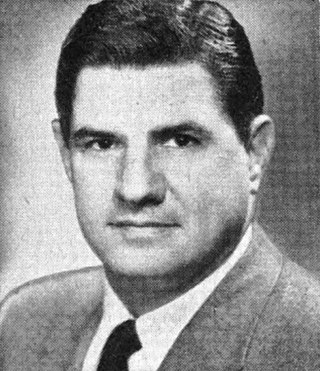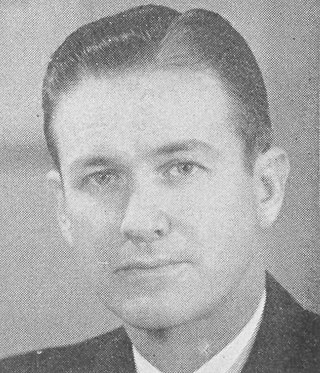
The National Security Act of 1947 was a law enacting major restructuring of the United States government's military and intelligence agencies following World War II. The majority of the provisions of the act took effect on September 18, 1947, the day after the Senate confirmed James Forrestal as the first secretary of defense.

The Gramm–Rudman–Hollings Balanced Budget and Emergency Deficit Control Act of 1985 and the Balanced Budget and Emergency Deficit Control Reaffirmation Act of 1987 were the first binding spending constraints on the federal budget.

Walter Reed was a U.S. Army physician who in 1901 led the team that confirmed the theory of Cuban doctor Carlos Finlay that yellow fever is transmitted by a particular mosquito species rather than by direct contact. This insight gave impetus to the new fields of epidemiology and biomedicine, and most immediately allowed the resumption and completion of work on the Panama Canal (1904–1914) by the United States. Reed followed work started by Finlay and directed by George Miller Sternberg, who has been called the "first U.S. bacteriologist".

William Huston Natcher was a Democratic congressman, serving in the United States House of Representatives from 1953 until his death from heart failure in Bethesda, Maryland in 1994. He is the second longest-serving member ever of the United States House of Representatives from the Commonwealth of Kentucky.

The 73rd United States Congress was a meeting of the legislative branch of the United States federal government, composed of the United States Senate and the United States House of Representatives. It met in Washington, D.C. from March 4, 1933, to January 3, 1935, during the first two years of Franklin D. Roosevelt's presidency. Because of the newly ratified 20th Amendment, the duration of this Congress, along with the term of office of those elected to it, was shortened by 60 days. The apportionment of seats in the House of Representatives was based on the 1930 United States census.

The 84th United States Congress was a meeting of the legislative branch of the United States federal government, composed of the United States Senate and the United States House of Representatives. It met in Washington, D.C. from January 3, 1955, to January 3, 1957, during the third and fourth years of Dwight D. Eisenhower's presidency. The apportionment of seats in the House of Representatives was based on the 1950 United States census.

The 83rd United States Congress was a meeting of the legislative branch of the federal government of the United States in Washington, D.C. from January 3, 1953, until January 3, 1955, during the last two weeks of the Truman administration, with the remainder spanning the first two years of Dwight Eisenhower's presidency. It was composed of the Senate and the House of Representatives. The apportionment of seats in the House was based on the 1950 U.S. census.

William Crawford Gorgas KCMG was a United States Army physician and 22nd Surgeon General of the U.S. Army (1914–1918). He is best known for his work in Florida, Havana and at the Panama Canal in abating the transmission of yellow fever and malaria by controlling the mosquitoes that carry these diseases. At the time, his strategy was greeted with considerable skepticism and opposition to such hygiene measures. However, the measures he put into practice as the head of the Panama Canal Zone Sanitation Commission saved thousands of lives and contributed to the success of the Canal's construction.
The McGovern–Hatfield Amendment was a proposed amendment to an appropriations bill in 1970 during the Vietnam War that, if passed, would have required the end of United States military operations in the Republic of Vietnam by December 31, 1970 and a complete withdrawal of American forces halfway through the next year. It was the most outstanding defiance of executive power regarding the war prior to 1971. The amendment was proposed by Senators George McGovern of South Dakota and Mark Hatfield of Oregon, and was known as the "amendment to end the war."

The 39th United States Congress was a meeting of the legislative branch of the United States federal government, consisting of the United States Senate and the United States House of Representatives. It met in Washington, D.C., from March 4, 1865, to March 4, 1867, during Abraham Lincoln's final month as president, and the first two years of the administration of his successor, Andrew Johnson.

The 54th United States Congress was a meeting of the legislative branch of the United States federal government, consisting of the United States Senate and the United States House of Representatives. It met in Washington, D.C., from March 4, 1895, to March 4, 1897, during the last two years of Grover Cleveland's second presidency. The apportionment of seats in the House of Representatives was based on the 1890 United States census. The House had a Republican majority, and the Republicans were the largest party in the Senate.

William John Hughes was an American politician and diplomat who served as a Democratic member of the U.S. House of Representatives from 1975 to 1995, representing New Jersey's Second Congressional District which includes major portions of the Jersey Shore and Pine Barrens, the cities of Vineland and Atlantic City, and the counties of Salem, Cumberland, Atlantic, Cape May and part of Gloucester. After retiring from Congress in 1995, Hughes was appointed by President Bill Clinton as United States Ambassador to Panama, a post he held until October, 1998 leading up to the historic turnover of the Panama Canal to Panamanian control.

The Mount Vernon Arsenal is a former United States Army munitions depot (arsenal), was used as a prison for captured Native Americans, and was served as a psychiatric hospital. It is listed on the National Register of Historic Places in Mount Vernon, Alabama. The site is home to the now closed Searcy Hospital. It was listed on the National Register of Historic Places on May 26, 1988, as the Mount Vernon Arsenal-Searcy Hospital Complex.

Page Henry Belcher was an American Republican politician and a U.S. Representative from Oklahoma.

Joe Madison Kilgore was an American lawyer, politician, and decorated World War II veteran who served five terms as a U.S. Representative from Texas's 15th congressional district from 1955 to 1965.

Omar Truman Burleson was an attorney, judge, FBI agent and veteran of World War II when he was first elected in 1946 as a Democratic U.S. Representative from Texas's 17th congressional district. He was re-elected to Congress from this rural district for more than 30 years, resigning in December 1978 rather than run again for office.
The Affordable Health Care for America Act was a bill that was crafted by the United States House of Representatives of the 111th United States Congress on October 29, 2009. The bill was sponsored by Representative Charles Rangel. At the encouragement of the Obama administration, the 111th Congress devoted much of its time to enacting reform of the United States' health care system. Known as the "House bill,” HR 3962 was the House of Representatives' chief legislative proposal during the health reform debate.

The Medal of Honor (MOH) is the United States Armed Forces' highest military decoration and is awarded to recognize American soldiers, sailors, Marines, airmen, guardians and coast guardsmen who have distinguished themselves by acts of valor. The medal is normally awarded by the President of the United States and is presented "in the name of the United States Congress."

La Follette–Bulwinkle Act or Venereal Diseases Control and Prevention Act of 1938 sanctioned federal assistance to U.S. states establishing preventive healthcare for venereal diseases. The United States federal statute commissioned the United States Public Health Service for demonstrations, investigations, and studies as related to the control, prevention, and treatment of opportunistic infections. The public law amended the Army Appropriations Act of 1918 appending the judicial context which created the Division of Venereal Diseases within the Bureau of the Public Health Service.

Port Mansfield Channel or Mansfield Cut is an artificial waterway encompassing the Laguna Madre positioned at the 97th meridian west on the earth's longest barrier island known as Padre Island. During Post–World War II, the tidal inlet was dredged as a private channel differentiating North Padre Island better known as Padre Island National Seashore and South Padre Island. The navigable waterway was channeled during the late 1950s ceremoniously cresting the intertidal zone of the Gulf of Mexico by September 1957 on the Texas Gulf Coast.















